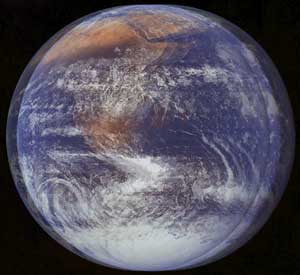|
 The
earth wobbles in space. This has been known for over a
century by astronomers, and thanks to global positioning
system (GPS) technologies, this wobble has been tracked
with a precision of a few millimeters over the last decade.
Until now, there were good theories as to why this happens,
but no one could really prove it. The
earth wobbles in space. This has been known for over a
century by astronomers, and thanks to global positioning
system (GPS) technologies, this wobble has been tracked
with a precision of a few millimeters over the last decade.
Until now, there were good theories as to why this happens,
but no one could really prove it.
Now, however, Geoff Blewitt, University
of Nevada research geophysicist, has an explanation for
this mysterious geo-wobble.
“The theory, which my colleagues
and I have proven using GPS observations of the Earth,
is that it’s likely to be caused by the surface matter
being redistributed,” Blewitt said. Blewitt and his
colleagues, Richard Gross, Jet Propulsion Laboratory;
Peter Clarke, University of Newcastle-upon-Tyne, England;
and David Lavallée, University of Colorado, Boulder;
published their findings in an article published April
1 in the journal, Geophysical Research Letters.
To make the Earth wobble, large amounts
of mass need to be moved from one place to another so
that the Earth is “off balance,” according to
NASA-funded researcher Blewitt, who said the North Pole
then adjusts to a new position to compensate. Large amounts
of water are displaced seasonally when glaciers and ice
sheets melt in spring, for example. The mass shifts back
when they refreeze in winter.
“We measured the earth’s shape
directly,” he said. “It agrees with the wobble.
What our measurements are showing is that everything is
consistent — the earth is wobbling while it’s
changing its shape,” he said.
“The Earth isn’t a perfect sphere,”
Blewitt noted. “It bulges at the equator because
it’s spinning. If the position and height of that
bulge changes slightly — even a few millimeters —
we can pick it up.”
Blewitt will present his findings on why
the Earth wobbles in a lecture, “GPS as a global
sensor of systems Earth,” at the 2004 Joint Assembly
of the American Geophysical Union, the Canadian Geophysical
Union, The Society of Exploration Geophysicists, and the
Environmental and Engineering Geophysical Society, on
Thursday, May 20, in the Palais des Congrès, Montreal.
Blewitt has contributed to four books
and co-authored some 60 papers in journals including Nature
and Science, as well as given presentations and workshops
at some 75 scientific conferences worldwide. Blewitt has
been at Nevada since 1999, with previous positions at
the University of Newcastle upon Tyne, England, and the
Jet Propulsion Laboratory at the California Institute
of Technology, Pasadena.
|